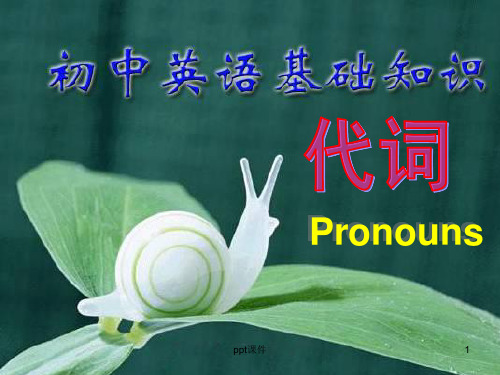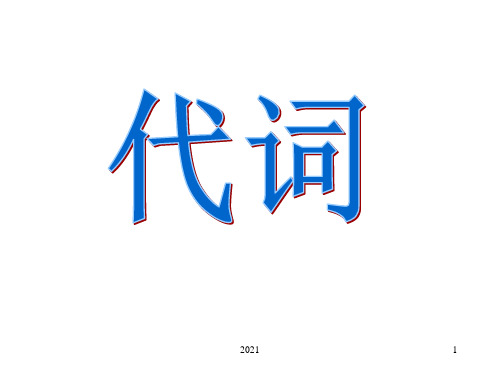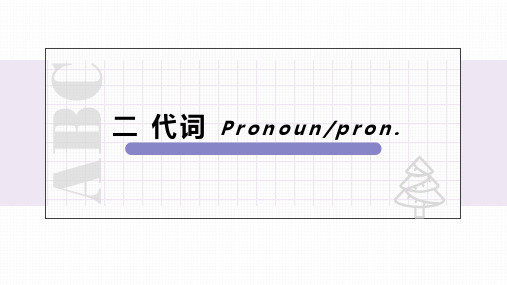初中英语语法代词PPT
初中英语语法—代词 ppt课件

Internet . A. go B. to go
C. going
ppt课件
12
二.物主代词
人称
分
第一人称 单数 复数
第二人称 单数 复数
第三人称 单数 复数
类
形 容 词 性
my
our
your
your
his her its their
名 词 mine ours yours yours his hers its theirs 性
ppt课件 10
5. 某人花费…做某事 It takes sb. some time to do sth. 6. 自从…以来,已经有…(时间)了。 It is / has been + 时段 + since + 从句(过 去时)
7. 某人发现/认为/感觉到做某事是…的 find sb. think feel
ppt课件 20
1.The man is rich , he can buy ___ a lot of things .
A. he B. his C. himself
2. --- What a lovely card ! Where did you buy it? --- I made it by _____.
ppt课件 18
三.反身代词
1.反身代词分类
人 称 分类 单 数 第一人称 第二人称 第三人称
myself
yourself
himself herself itself themselves
19
复 数
ourselves yourselves
ppt课件
2. 反身代词常见固定搭配
① 过得愉快 enjoy oneself ②自学 teach oneself. ③ 请随便吃… help oneself to sth. ④ 自言自语 say to oneself ⑤ 独自 all by oneself/ by oneself ⑥ 为自己 for oneself ⑦ 不要客气 make oneself at home ⑧ 陶醉/沉浸于 lose oneself in… ⑨ 自己穿衣服 dress oneself ⑩ 照顾自己 look after oneself
初中英语语法总结-代词(共15张PPT)

功能 形容词性物 作主语 主代词 名词性物主 作主语 代词 作宾语 作表语 与of连用 作定语 例句 Her father is a doctor. This is her pen. Mine is broken. Her spoken English is better than mine. That pencil is hers. The blue coat of his is very beautiful. 备注 形容词性物主代词作定语 相当于形容词 名词性物主代词在句中不 能单独作定语。如: Yours English is better than hers Your English is better than hers.
none
指代人或物 可与of连用, 谓语动词用单复数均可 回答how many/much的提问
—Sorry, we’ve got none left.对不起,一张也没有了。
—Who is absent from classes today? 今天谁没有来上课? —No one, sir.没人缺席,先生。 —Tickets for Friday?星期五的票(还有吗)? None of them is/are in the classroom. 他们当中没有一个在教室里。
Tips: 1)排列顺序: 单数:二、三、一; You, he and I are all 复数:一、二、三; We, you and they are students. 2)第一人称单数代词I , 无论 在什么地方出现都要大写。
作形式主语、形式 宾语
指前文提到的物 指不知性别的婴儿 或不确定性别的人
词条 each every 每个(强调个体) 每个(整体描述) 用法 作主语、宾语、定语、同位语 两者或两者以上 只能作定语 三者或三者以上 可与of搭配 不可与of搭配
《英语语法代词》PPT课件

Nobody but she can solve our problems .
2,但若以上主语与被分隔使用”but/except+人称代词”这一介词 词组出现在结尾时,则人称代词用宾格:
I cannot see myself allowing people to cheat me.
反身代词做主语补语属于强调型用法,这种用法通常表示身 体状况或作并列补语的一部分。例如:
Ah,that is it.You are yourself again.(恢复正常了) 提醒:”no one but+人称代词“作主语通常用主格。例如:
Your Problems—We Solve
1,什么是分裂句? 2,正式用语与非正式用语的区别? 3,通性名词与中性名词的区别? 4,who与whom如何区分用法? 5,如何翻译Mrs Smith will go and see Nancy
herself.与He spoke to the president himself. 如何避免歧义现象? 6,限定词与代词的关系?
◆分裂句的谓语动词be还可以采取复杂形式。
eg: It may have been at Christmas that John gave Mary a handbag. 约翰可能是在圣 诞节送给玛丽一个手提包的。
◆分裂句可以强调多种多样的状语成分,例如强调时间状语、地点状语、方式 状语等。例如:
It was when she was about to go to bed that the telephone rang. 正是在她要去睡觉的 时候,电话铃响了。
初中英语语法讲解第四章代词(一)

初中英语语法讲解第四章代词(Pronouns)代词:是代替名词以及起名词作用的短语、动词不定式、V-ing 形式、从句或句子的词。
一.代词的分类英语中代词分为九类:人称代词、物主代词、反身代词、指示代词、相互代词、疑问代词、不定代词、关系代词和连接代词。
分类及及例词如下:人称代词 I we you he she it them物主代词 my your his her our their mime hers theirs ouss 反身代词 myself yourself ourselves itself themselves指示代词 this that these those相互代词 each other one another疑问代词 who whom whose which what不定代词 all some any much many few little关系代词 who whom whose that which as连接代词who whom whose which what二、人称代词(主要用来指人的代词,也可指物)1、人称代词的形式人称代词有主格和宾格,有单复数形式2、人称代词的句法功能人称代词有主格和宾格之分,主格形式在句中作主语、表语等成分,宾格形式在句中作动词宾语、介词宾语、同位语等。
巧记:主格、宾格姐妹俩,人称代词是一家;宾格负责迎“宾”客,主格作“主”来当家。
⑴人称代词主格的句法功能①作主语 e.g. I’m a student. You are a teacher. We all work very hard.②作表语,用在“It’… who(that)…”结构中 e.g. It’s she who has been wrong.⑵人称代词宾格的句法功能①作及物动词的宾语 e.g. Tell him\her to call back a little later.②作介词宾语 e.g. This pen is bad. I can’t write with it.I believe in you .③作同位语 we , us three will be able to finish the work .④作表语人称代词作表语时,通常要用宾格e.g. —Who is knocking at the door? —It’s me.3、使用人称代词需注意的几点①主格I 在句中的任何位置都必须大写Mum suggests that I should cheer up when meeting with failure .②在英语中如果出现多个人称代词,单数并列为you ,he/she and I 或you ,him/herand me ; 复数并列为we ,you and they 或 us ,you and them . 如果需承担责任,说话者则把第一人称放在第一位。
人教版初中英语语法知识学习课件PPT之代词语法学习PPT

are my sister’s.
考点学习
归纳拓展 (1)that/those, one/ones: ①that指代上文提及的单数可数名词或不可数名词;those指代上文提及的 复数可数名词。如:
·The water in the cup is hotter than that in the bottle. ·The values of today’s young people are different from those of their parents.
考点学习
(3)名词性物主代词可以作主语、表语和宾语,其后不能跟名词。名词 性物主代词相当于"形容词性物主代词+名词"。如: —Whose camera is this? Is it yours? —No, it’s not mine. It’s his.[2022天津中考]
考点学习
反身代词 (1)反身代词可以在句中作宾语、同位语。如: ·Be careful! Don’t hurt yourself! ·The matter itself is not serious.
人教版初中英语语法知识学习课件PPT Nhomakorabea代词语法学习
图解语法
考点学习
考点 1 人称代词、物主代词和反身代词
类别 第一人称 第二人称
单数 复数 单数 复数
人称代词 主格 宾格
I me we us you you you you
物主代词
形容词性 名词性
my
mine
our
ours
your
yours
your
himself herself itself themselves
考点学习
代词知识点详解(14张PPT)初中英语专题复习课件

enjoy oneself 玩得开心 help oneself to 随便(吃、喝) lose oneself in... 沉浸在……之中
反身代词
➢ 例 Help
to some fish, Jim.
A. himself
B. herself
C. yourself
➢ 解析 句意:吉姆,随便吃些鱼吧。考查短语help oneself to sth."随便吃/
指代离自己较近的人或物 this, these
指代离自己较远的人或 物 比较结构中代替前面提 到的名词,以免重复
that, those
疑问 代词
指示 代词
不定 代词
代词
人称 代词
物主 代词
反身 代词
语法图解
someone/somebody/something, anyone/anybody/anything, nobody/nothing everyone/everybody/everything等
many/much, few/a few, little/a little, other/the other/another/others, some/any, either/neither/both/all等
复合 不定 代词
普通 不定 代词
疑问 代词
指示 代词
不定 代词
代词
人称 代词
物主 代词
反身 代词
人称代词与物主代词
区分 人称代词
用法
成分
指代人或物 作主语(主格),作宾语(宾格)
物主代词
表示所有关系
形容词性物主代词作定语 名词性物主代词=形容词性物主代词+名词,具有名 词特性,可作主语、宾语、宾补
初中英语语法大全——代词(共34张PPT)

C. 用来指代婴儿和不知身份,性别的人 Who is dancing in the classroom? It must be Lily. The baby is cr ying. It might be hungr y. D. 做形式主语或形式宾语 it可以代替不定式,动名词,从句等做形式主语或形式宾语, 而把真正的主语和宾语置于句末。 It's hard work keeping the grass green at this time of year. Did you find it very interesting to play volleyball?
4. either,neither
(1) either表示“两者中的任何一个”,做主语时,谓语动词常用单 数形式,起其后可接of短语。 You can come on Saturday or Sunday. Either is OK for me. We can't care much for what to eat. Either of the two will do. (2) neither 表示“两者都不”,做主语时,谓语动词常用单数形式, 其后可接of短语。 We have red and yellow T-shirts. Which color do you like? Oh, neither. I think blue will be OK. Neither of them wants to speak to him about this matter.
2. that和those作替代词的用法
为了避免重复,that可指代前面提到的单数可数名词 和不可数名词,those可代替复数可数可数名词,其 后总有修饰。
In summer in Beijing is cooler than that in Shanghai.
代词考点详解(15张PPT)初中英语专题复习课件

“任何数量;任何一些”,指代复数 里 有 吗 ? Please buy some milk. There
名词或不可数名词
isn’t any left in the fridge. 请买些牛奶。
冰箱里一点也没有了。
I have three dictionaries. You may use
② 用于肯定句中,表示“任一”
(5)复合不定代词的用法
由 some , any , every , no 与 one , body , thing 一 起 构 成 的 代 词 叫 复 合 不 定 代 词 , 如 something,everybody,anyone,nothing等。由one和body构成的复合不定代词可相互换用。
结构
另一个是老师。
其他全部,其余的。表示在一个范 围内的其他全部
In our class only Tommy is English, and the others are Chinese. 我们班除了汤米是英国人外,其他都是中国人。
另一个(指多个中的任何一个),可 You can see another ship in the sea, can’ t
第二人称
单数 复数 单数 复数
汉语 我的 我们的 你的 你们的
形容词性 my our your your
名词性 mine ours yours yours
他 he him
他的 his his
第三人称
单数
她
它
she
it
her
it
第三人称 单数 她的 它的 her its hers its
复数 他们 they them
三、反身代词
反身 代词
初中英语语法专题课件完整版(共983张PPT)

2.不规则变化
构成方法
例词
形式不变 (单复数同形)
sheep-sheep deer-deer Chinese-Chinese Japanese-Japanese
变内部元音字母
foot-feet tooth-teeth goose-geese man-men mouse-mice
词尾加-en/-ren
a group of 一队,一组,一群
②还可用much,little,a little of,a large amount/deal of, no,plenty of等来修饰不可数名词,some,any既可修饰可数名词也可修 饰不可数名词。
much money,plenty of water a little of air some(肯定句): some milk ,some apples any(疑/否):Are there any stamps?I don’t have any money (5)数词-名词-形容词构成的复合形容词,中间的名词不能用
普通名词又可分为下面四类:
1)个体名词:表示单个人或单个事物。 如:gun、kid 、book。 2)集体名词:表示一群人或一些事物组成的集合体。 如:family。
3)物质名词:表示无法分为个体的物质、材料、食品、饮料、液体、气体、 金属等名称的名词,
如:pork、wood、bread、water、air。 4)抽象名词:表示动作、状态、品质、感情等抽象概念及学科、疾病。 如:work 。Hunger、honesty 、love、Chinese、success、HIV。 个体名词和集体名词可以用数目来计算,称为可数名词。
f,fe 为v,再加 -es
shelf-shelves thief-thieves
英语代词PPT课件

2021
22
1、疑问代词
疑问代词主要有:
who谁(主格)
whom谁(宾格)
whose谁的(属格)
what 什么(人、物)
which哪一个、哪些(人、物)
some一般用于肯定句中,any多用于疑问句 否定句和条件句中。
但在疑问句中,若要表示说话的人想要得 到肯定地回答或表示建议请求时用some。
2021
31
many much
many修饰可数名词复数,还可以与表示程 度的副词so too as how 连用。
much修饰不可数名词,也可以与表示程度 的副词so too as how连用。
—____.I am not their fan.
A.Both B.Either C.Neither D.All
C both两者都; either表示选择,两 者中任何一个; neither两者都不; all 三者或三者以上都。根据句意应选C。
五 普通不定代词 及复合不定代词
2021
29
1.常用普通不定代词 some any many much each every few little either neither both all none one other
2021
30
2.普通不定代词的用法
some any
some any均表示一些,即可修饰可数名词, 也可以修饰不可数名词。
2021
1
人称代词
主格 宾格
物主代词 形容词性
代
反身代词
初中英语语法:代词(共92张)

last night?
7 不定代词
7.1 some/any/few/little 7.2 both/neither/either/all/none 7.3 each/every 7.4 one/ones 7.5 another/the other/others/the others 7.6 a number of/a great deal of
LOGO
我可爱的妹妹们有一辆新的自行车
My lovely sisiters has a new bicycle.
【误】Lovely my…… have
注意② 形容词性物主代词与形容词一起修饰名词时 其顺序是:形容词性物主代词+形容词+名词 注意③ 形容词性物主代词所修饰的名词可以是单数, 也可以是复数。
7.7 复合不定代词
人称代词
LOGO
第一人称:自称“吾”“我”“余”“予”“朕”“孤”“寡人” 第二人称:对称“尔”“汝”“女”“若”“乃”“而” 第三人称:他称“彼”“其”“之”
我/你/他/她/它 我们/你们/他们/她们/它们
LOGO
LOGO
LOGO
主格:作主语,表示谁怎么样了、干什么了。
7.1 some/any/few/little LOGO
many修饰【C】much【U】
Peter has_______friends. Peter has_______food for his birthday party.
how many修饰【C】how much【U】
______________tea is there in the cup? ______________pieces of bread are there on the
初中英语语法词类——不定代词(PPT22张)

①复合不定代词somebody ,something ,anything, nothing ,everything, everybody等是由some ,any,no,every 加上body, thing 构成的,叫做复合不定代词,在句子中当单数使用。
e.g.There is someone outside the door.
③a number of / large numbers of只可以修饰可数名词复数形式(它修饰的词作主语时谓语用 复数形式)可以换为some、many、a lot of、plenty of 。
e.g.i have a number of letters to write today.
④ a great deal of只可以修饰不可数名词(它修饰的词作主语时谓语用单数形式)可以换为much e.g.I spend a great deal of money on shopping.
e.g.Each of them has something to do.
③every和each都用作单数理解,但是下文中既可以用单数的代词(如he/him/his)也可以用复数的 代词如they/them/their)替代。
e.g.Every one of the students in his class studies very hard.
PART/02 不定代词
(9)few、a few、little、a little的用法
①few、little意思是“很少几个”、“几乎没有”,有否定的意思;a few、a little意思是“有几 个”、“有些,有肯定的意思
e.g.He is poor and he has little money. Don't worry,there is still a little time left.
人教版九年级英语上册课件初中英语语法—代词

③ 请随便吃… help oneself to sth.
④ 自言自语 say to oneself
⑤ 独自
all by oneself/ by oneself
⑥ 为自己
for oneself
⑦ 不要客气 make oneself at home
⑧ 陶醉/沉浸于lose oneself in…
⑨ 自己穿衣服 dress oneself
1. --- Who is knocking at the door? --- I don’t know . I was lying in the bed
and just ask who ____ was. A. he B. she C. it
2. I can’t find my hat . I don’t know where I put ____.
1. -Look, who is coming?-___ must be our English teacher. A. She B. He C. It D. This
2. I found ___ not easy to get on with him.
A. that B. it C. this D. one
The weather in China is quite different from that in USA .
代词,指the weather
1.this和these用于指距离较近的事物或人,that和 those用于指较远的事物或人。如:This picture is
clear and that picture is not clear. 2. that(those)可以代替前面提到的名词,以免重 复,this(these)不能。如:The population of
中考英语语法代词(共52张PPT)

①都能与
of 短 语 连
主语、定语、宾语、同 位语
用, 且能 在句中作
主语、宾语、表语、定 主语
语、同位语
②都能单
主语、宾语、定语
独作主语
none
(≥3)都不
单/复数都 可以
主语、宾语
① of the boys in our class like Yao Ming. 我们班所有的男生都喜欢姚明。 ② can speak Japanese in our class. 我们班里无一人会说日语。
或距离
现在是八点钟,雨下得正大。
—What’s that?
(3) 答 语 中 代 替 ——那是什么?
this/that
—It’s a snowball.
——它是一个雪球。
(4)形式主语常见句 式
(5)形式宾语
A. It’s +adj. + (for sb. ) to do sth. B. It’s time for sb. to do sth. C. It takes (took/will take)sb. +时间+to do sth. D. It seems +that从句 E. It’s +adj. +that从句
【温馨提示】
it的其他用法
(1)代指婴儿或不明 身份的人
—Who’s knocking at the door? ——谁在敲门? —It must be my brother. ——它一定是我的弟弟。
(2) 表示 天 气 、 时 间 It’s 8: 00 now and it’s raining hard.
eacheitherbothallneithernone意义谓语动词形式句中的作用相同点each每一个2单数形式主语宾语定语同位语都能与of短语连用且能在句中作主语都能单独作主语either两者中的任何一个单数形式主语宾语同位语both两者都复数形式主语定语宾语同位语all都3复数形式主语宾语表语定语同位语neither两者都不单数形式主语宾语定语none3都不单复数都可以主语宾语oftheboysinourclasslikeyaoming
初中全新英语语法——代词(共33张PPT)

(2)人称代词作表语,口语中通常用宾格而不用 主格。如: —Who’s it? 谁啊? —It’s me.是我。 (3)人称代词单独使用或作问句的简略回答时通 常用宾格而不用主格。如: —I like dancing.我喜欢跳舞。 —Me,too.我也是。 —Who broke the window?是谁打破了窗子? —Me./Not me.是我。/不是我。
2.物主代词的用法4注意
(1)形容词性物主代词只能放在名词的前面作定语。即形 容词性物主代词的后面须有一个名词。 如:This is my bike. 这是我的自行车。 Our school are having a sports meeting.我们学校正 在举行运动会。 (2)名词性物主代词在句中可作主语、宾语和表语,其后 不能再加名词。如: The bag looks like yours.那个书包看上去像你的。 Mine is blue.我的是蓝色的。 That book isn’t mine.那本书不是我的。
(3)名词性物主代词不能作定语,但“of+名词性 物主代词”常用来作后置定语,如:
She is a friend of mine.她是我的一个朋友。
(4)汉语中“我父亲、他妈妈、我们学校”等中 的代词实际上是英语中的形容词性物主代词,千万 不要把上面的短语翻译成“I father,he mother, we school”,而应译成“my father,his mother,our school”。
2.人称代词使用6注意
(1)人称代词作主语时用主格,作宾语时用宾格, 切不可张冠李戴。
He plays table tennis every day.他每天都打乒 乓球。(“他”在句中作主语,用主格he。)
英语语法代词课件

代词1、语法功能人称代词有主格宾格之分。
主格形式在句中作主语,表语等成分。
宾格形式在句中作宾语,介词宾语,同位语等成分,有时也作表语。
Who is there murmuring?谁在低声说话?It’s I /me.是我。
2、用法详解(1)we, you, they, he表示泛指,都可以指“人们”,单数用he。
(2)he,she 表示物。
Q指代宠爱的动物,通人性的动物往往用he, she。
不带有感情色彩的用it。
女主人常用she, her表示自己的爱车,宠物等;男主人常用she, her表示自己的爱车,宠物等。
Q She可以用来表示国家,船只,大地,月亮等。
Q诗歌、寓言、故事中,温柔、善良的动物(鹿、猫、熊猫、小鸟等)常用she代替,凶猛的动物(老虎、狮子、狼、狐狸等)常用he替代。
(3)人称代词用于as, than之后如果as, than看作介词,此时往往用宾格;如果是连词,用主格。
She speaks Chinese as well as me/I.(此时口语中常用me)She speaks Chinese as well as I do.(此时把as 作连词)(4)人称代词单独使用,常用宾格不用主格。
Me too.(5)几个人称并列时的顺序Q 单数场合:you + he/she + IQ复数场合:we + you + theyQ男女两性并列场合:he + sheQ承担责任时:把I (me)或we (us)放在第一位I and he are blame for the accident.Q长辈对晚辈,长官对下属说话时,如果长辈、长官是第一人称可放在前面。
I and my son went hiking yesterday.Q相当于形容词,置于名词前,作定语。
Q one's own短语表示强调,“完全属于自己”“自己的”@形出容词性物主代词构成固定短语,此时代词不可少。
Do one's homework 等关于名词性物主代词1、作用反身代词与所指的名词或代词形成互指关系,在人称、性、数上保持一致。
- 1、下载文档前请自行甄别文档内容的完整性,平台不提供额外的编辑、内容补充、找答案等附加服务。
- 2、"仅部分预览"的文档,不可在线预览部分如存在完整性等问题,可反馈申请退款(可完整预览的文档不适用该条件!)。
- 3、如文档侵犯您的权益,请联系客服反馈,我们会尽快为您处理(人工客服工作时间:9:00-18:30)。
人称代词
• 人称代词有主格和宾格之分,主格形式在句中作主语、表语等成分, 宾格形式在句中作宾语、同位语等,有时也作表语。 I love climbing. It keeps me fit. ----Who took away all the books here?----It’s I/me. 1 it最基本的用法就是代替前面提到过的事物以避免重复。 2 she, he的特殊用法: she可以用来代指国家、船只、大地、月亮等。 China will always do what she has promised to do. Titanic was the greatest ship of the time but she sunk down to the bottom of ocean. 男主人常用she/her代指自己的爱车、宠物等 女主人常用he/his代指自己的爱车、宠物等 My car still runs perfectly. He/She/It has been working for me a dozen years. 在寓言故事中,温柔、善良的动物(鹿、猫、熊猫、小鸟等)常用she代 替,凶猛、粗野的动物(老虎狮子狼熊狐狸等)常用he代替
物主代词
• 物主代词是表示所有关系的代词 1 形容词性物主代词用作定语,来修饰它后面 的名词 2 名词性物主代词作名词用,因此,后面不能 再接名词。它在句中作主语表语、宾语或 与of构成短语作定语,可以避免与前面已经 提到的名词重复。
名词性物主代词
第一人称:mine ours 第二人称:yours 第三人称:his , hers, its , theirs. P15exercises 2. This is pen. That is ,too..3. 3.This scarf. That is too. 4.This is newspaper.That is ,too. 5.These are children. Those are 6.These are students. Those are
Some 也用在下面疑问句中
• • • • • • • • 1.Would you like some coffee? 2.Will you lend me some books? 二、 可数名词与不可数名词。 1.个体名词:man, teacher, student 2. 集体名词:class, team, army. *以上两种名词属于可数名词。 3.物质名词:milk cotton air 4. 抽象名词:love happiness life
指示代词
• 指示代词是用来指代或标记人或事物的代词,表示“这个, 这些,那个,那些” • this, that, those, these 1 this, these指时间或空间较近的人或物;that, those指较远的 2 that, those常常用来代替前面已经提到过的事物,以避免重 复 The life in the country is more peaceful than that in the city. Subjects for middle school students in China are a little more difficult than those in the U.S.
• 人称代词中需要注意的:
1 主格I在句中的任何位置都要大写 2 如果出现多个人称代词 单数:你,他/她,我 复数:我们,你们,他们 如果需要承担责任:我放在第一位 3 人称代词单独使用时,常用宾格而不是主格 ------I’d like to stay here for another week. ------Me, too.
二 代词的分类及用法
• 代词按意义、特征及语法功能可分为9类: 1 人称代词(主格,宾格) 2 物主代词(形容词性,名词性) 3 反身代词 4 相互代词 5 指示代词 6 不定代词 7 疑问代词what, who, which, whom, whose 8 连接代词that 9 关系代词who, that, which, whom, whose, as
代
词
一 代词概述
• 代词(Pronouns)是代替名词以及起名词作用 的短语、不定式、动词-ing形式、从句或句 子的词。 • 在英语中代词用得极为广泛。正确运用代 词可以使句子简洁、明快,但如果使用不 当也容易产生意义理解上偏差。 • 值得注意的是:数词是表示数目多少或顺 序先后的词,其用法与不定代词具有相似 之处。
疑问代词
• • • • • who whom whose which what
不定代词
1 all, both, none 2 不定代词one指代可数名词,可指人或物。one既可以单独使用,也可 以放在可数名词单数的前面作定语,复数形式ones,所有格形式one’s, 反身代词oneself 注:it, one都可代替上文出现过的名词,但是it往往指上文出现过的特 定的事物,即同一事物,而one则代替与前面事物同属一类的事物, 并不是指同一事物。 The electrical fan is new, but it doesn’t work well. The electrical fan doesn’t work well. I’ll try a new one. 3 each, every 4 some, any 5 other, another 6 either, neither 7 many, much 8 little, a little, few, a few 9 复合不定代词
,too. .
反身代词
• 反身代词是一种表示反射或强调的代词
• 通过反身代词指代主语,使施动者把动作在形式上反射给 施动者自己。
• 反身代词与它所指的名词或代词形成互指关系,在人称、 性别、数上保持一致。 1 作及物动词的宾语 Please help yourself to some tea. 2 作介词宾语 You can go and see for yourself. 3 作表语 Bob is not quite himself today. 4 作同位语,表示强调 ,可置于名词代词之前、之后或句子 末尾。I fixed the windows myself. 5 固定短语 by oneself独自一人 dress oneself穿衣 call oneself 自称 devote oneself to 献身于 say to oneself 自言自语
相互代词
• 表示相互关系的代词叫相互代词,有each other和one another两组,用来表示两个或 两个以上的人或物之间的关系 1 用作宾语 We love each other. 2 所有格形式用作定语 We should point out one another’s mistake.
பைடு நூலகம்
不定代词
• 普通不定代词: some, any, one, none somebody, anybody, nobody, someone, anyone, no one, something, anything, nothing • 个体不定代词: each, other, another, either, neither, half everybody, everyone, everything • 数量不定代词: all, both, many, much, few, little, a few, a little, a lot of, lots of, a great deal, a great many, other, others, another, the other
Unit 4 不定代词
• 1.some:用在肯定句中,修饰可数名词和不 可数名词。 • There is some coffee. • 2.any:用于疑问句和否定句。 • Is there any milk in the bottle? • I haven’t got any brothers. • 3.no:作定语,修饰可数不可数。 • There is no sugar in the box.
